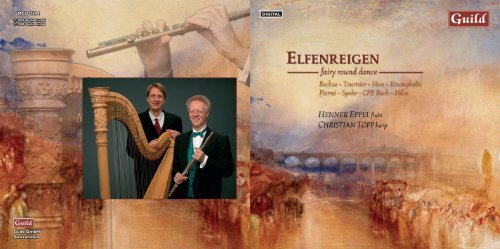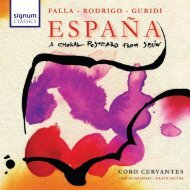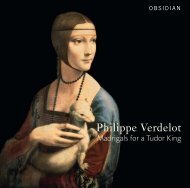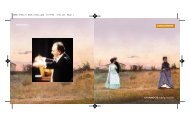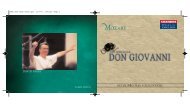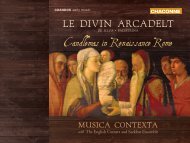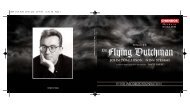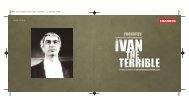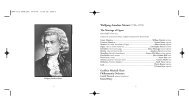GMCD7294 Elfenreigen Flute Harp.indd - Chandos
GMCD7294 Elfenreigen Flute Harp.indd - Chandos
GMCD7294 Elfenreigen Flute Harp.indd - Chandos
You also want an ePaper? Increase the reach of your titles
YUMPU automatically turns print PDFs into web optimized ePapers that Google loves.
GMCD 7294<br />
2005 Guild GmbH<br />
© 2005 Guild GmbH<br />
DIGITAL<br />
Guild GmbH<br />
Switzerland
1<br />
2 1. Très lent [2:05] 3 2. Allegro moderato [1:32]<br />
4<br />
5<br />
6<br />
8<br />
9<br />
Robert Nicolas Charles BOCHSA (1789-1856)<br />
Nocturne Concertant in G minor Op. 71 No. 3 10:26<br />
Marcel TOURNIER (1879-1951)<br />
Deux Préludes Romantiques Op. 17 3:37<br />
Willy HESS (1906-1997)<br />
<strong>Elfenreigen</strong> Op. 79 4:14<br />
Johann Baptist KRUMPHOLTZ (1747-1790)<br />
Sonata in F major Op. 8 No. 5 13:35<br />
1. Allegro [6:03]<br />
2. Romance [3:43] 7 3. Tempo di Minuetto en Rondo [3:49]<br />
Gabriel PIERNÉ (1863-1937)<br />
Impromptu-Caprice in A flat major Op. 9 for harp 5:25<br />
Louis SPOHR (1784-1859)<br />
Sonata in C minor WoO 23 16:03<br />
1. Adagio–Allegro vivace [8:15] 10 2. Andante–Allegro–Andante–Allegro [7:48]<br />
Carl Philipp Emanuel BACH (1714-1788)<br />
Hamburg Sonata in G major Wq. No. 133 9:47<br />
11 1. Allegretto [6:51] 12 2. Presto [2:56]<br />
Bruno HILSE (19th/20th century)<br />
Suite Op. 6 15:11<br />
13 1. Andante [3:58] 15 3. Adagio [5:37]<br />
14 2. Bacchanale [2:50] 16 4. Scherzo [2:46]<br />
A GUILD DIGITAL RECORDING<br />
• Recording Engineer and Editing: Jochen Weyer<br />
• Recorded: House of Audio Studios, D-76689 Karlsdorf, Germany, October 2003<br />
• Final master preparation: P. J. Reynolds Mastering, PO Box 5092, Colchester CO1 1FN, UK<br />
• Cover picture: Heidelberg c. 1846, detail, by J. M. W. Turner (1775-1851) © National Galleries of<br />
Scotland<br />
• Artist photographs: Photoatelier Gös, Heidelberg<br />
• Design: Paul Brooks, Design & Print – Oxford<br />
• Art direction: Guild GmbH<br />
• Executive co-ordination: Guild GmbH<br />
• Portraits: C. P. E. Bach – Print by Johann Conrad Krüger (© Bibliothèque nationale de France);<br />
Bochsa – Lithography by Fritz Kriehuber with facsimile signature, Vienna 1842 (© Bibliothèque nationale<br />
de France); Erard – (© Bibliothèque nationale de France); Hilse – Facsimile signature, Leipzig 1911<br />
(© Zimmermann-Verlag Frankfurt/Main); Pierné – Photograph by Henri Manuel (© Bibliothèque nationale de<br />
France); Spohr – Self-portrait by Louis Spohr (c. 1807) (© International Spohr Society of Kassel, Germany)<br />
●<br />
●<br />
●<br />
GUILD specialises in supreme recordings of the Great British Cathedral Choirs, Orchestral<br />
Works and exclusive Chamber Music.<br />
Guild GmbH, Moskau 314b, 8262 Ramsen, Switzerland<br />
Tel: +41 (0) 52 742 85 00 Fax: +41 (0) 52 742 85 09 (Head Office)<br />
Guild GmbH, PO Box 5092, Colchester, Essex CO1 1FN, Great Britain<br />
e-mail: guildmusic@bluewin.ch World WideWeb-Site: http://www.guildmusic.com<br />
WARNING: Copyright subsists in all recordings under this label. Any unauthorised broadcasting, public<br />
performance, copying or re-recording thereof in any manner whatsoever will constitute an infringement of such<br />
copyright. In the United Kingdom licences for the use of recordings for public performance may be obtained from<br />
Phonographic Performances Ltd., 14-22 Ganton Street, London W1V 1LB.
Sébastien Erard<br />
Signature of Bruno Hilse<br />
The flute and the harp have been recognised as the well-loved instruments used<br />
for celebrations and religious services since the time of Ancient Egypt. Their<br />
beautiful and unique sound was not as many may think, discovered by the French<br />
impressionists towards the end of the 19th century! Indeed there are many paintings from<br />
the Middle Ages which not only document the existence, but also the popularity of these<br />
two instruments: the angelic music of the heavens almost always requires them. As the<br />
18th century came to an end the harp was placed alongside the singing sound of the flute,<br />
which itself had become the fashionable instrument for perceptive citizens and nobles<br />
alike. Neither fortepiano nor harpsichord could produce this unique sound. Moreover, the<br />
decorative effect of a beautifully patterned harp should not be underestimated! The private<br />
residences of the upper class along with churches, concert halls and opera houses were<br />
the most important places for musical performances and played host not only to famous<br />
pianists of the time like Chopin or Liszt, but also to harpists such as Elias Parish-Alvars<br />
(1808-1849) or Félix Godefroid (1818-1897).<br />
As a level of near technical perfection was reached in the construction of both<br />
instruments, new possibilities for playing arose. Prime examples are the conical flute in<br />
the old style and the two Theobald Boehm models from 1832 and 1847. The latter has,<br />
to this very day, undergone only minor modification. Above all the double-action harp of<br />
Sébastien Erard which received the patent No. 3332 in 1810, after years of development,<br />
and whose principle still serves as a model for today’s concert harps.<br />
If you glance at guides to chamber music which themselves usually list a ‘large’<br />
repertoire, you will be astonished to see how rarely the harp appears. The reasons for this<br />
are many. Besides reasons relating to the very particular sound of the harp it is also true<br />
to say that many composers were not familiar with the variety of musical possibilities the<br />
harp affords and what potential it possesses. There is hardly any another instrument that<br />
one needs to know as intimately as the harp in order to avoid demanding the impossible.<br />
For this reason harpists themselves largely composed the music they required for concert<br />
performance. Names such as Krumpholtz, Bochsa and Tournier are prime examples; they<br />
belonged to the greatest virtuosos of their time.<br />
18<br />
3
This collection spans from the end of the 18th century to the 20th century. The ‘solos’<br />
of the 18th century are played with a figured bass tone: this so-called general bass, derived<br />
from a form of musical shorthand, was freely played by the right hand of the keyboard<br />
instrument player, while the left hand played the notes from the manuscript and was<br />
frequently supported by another instrument (viola da gamba, cello or bassoon). One of<br />
the musicians should therefore be able to produce chord sounds. The spinet, harpsichord,<br />
organ, lute, guitar and piano were the favourites. The necessary chords could, however, also<br />
be produced by an experienced harpist.<br />
The Hamburg Sonata in G major, Wq. No. 133, was composed in 1786 by the most<br />
famous of Bach’s sons, Carl Philipp Emanuel BACH (1714-1788). All the other sonatas<br />
for flute and obligatory harpsichord, and those with the general bass accompaniment were<br />
written between 1735 and 1766. After 27 years in the service of the flute-playing Prussian<br />
King Friedrich the Great in Rheinsberg, Berlin and Potsdam, CPE Bach moved to Hamburg<br />
in 1768 where he succeeded his godfather Telemann. The general bass sonata played<br />
here has barely any likeness to the other sonatas of its creator. The bass in this instance is<br />
basically a foundation for the melodic flute part. That this work came about was the direct<br />
result of the influence of blind flautist Friedrich Ludwig Dulon (1769-1826). In the last<br />
movement there are clearly influences from great classical composers such as Haydn.<br />
Johann Baptist KRUMPHOLTZ (1747–1790) also Jean-Baptiste, Jan Ktitel, baptised<br />
Jan Martin, often stated as having been born in 1742 or 1745, which is not correct, was<br />
a composer and harpist of Bohemian origin. After a short stay in Vienna (to improve<br />
his horn-playing) he went to Paris with his father in 1760/61 to study horn and harp.<br />
In 1767 Krumpholtz returned to Prague and took lessons in counterpoint with Haydn<br />
and Wagenseil while he was a member of the band of Count Esterházy from 1773 to<br />
1776. Concert trips to Germany and France led him back to Paris where he settled as a<br />
very respected harp virtuoso, composer, music teacher and instrument-maker. Important<br />
technical improvements of the harp increased his initiative. He married in 1783 his student<br />
Anne-Marie Steckler (1766–1813), who left him in 1788 to go with the pianist Dussek<br />
to London. Lovesickness and fear of the Revolution drove him to commit suicide by<br />
4<br />
time he made several recordings for BBC Radio 2 and Radio 3. In 1997 he became a Bachelor<br />
of Music and in 1998 received the Concert Recital Diploma. In 2000 he took part in the<br />
Bayerischer Rundfunk Orchesterakademie Ingolstadt.<br />
As a soloist Christian Topp has performed harp concertos by JS Bach, Boieldieu, Debussy,<br />
Glière, Handel, Mozart, Vivaldi and Wagenseil.<br />
He has played in several orchestras in South Germany and was principal harpist with<br />
the Orchester des Pfalztheaters Kaiserslautern. At the moment he is principal harpist with the<br />
Neue Lausitzer Philharmonie.<br />
Since 1990 Christian Topp has been playing on a regular basis in a flute and harp<br />
combination and, since 2001, with Henner Eppel.<br />
Im Alter von neun Jahren erhielt Christian Topp, geboren 1973, seinen ersten Harfenunterricht<br />
bei Imme Atwood in Basel. Von 1991 bis 1993 wurde er als Jungstudent an der Staatlichen<br />
Hochschule für Musik München von Prof. Helga Storck unterrichtet. 1993 gewann er den<br />
Landeswettbewerb „Jugend musiziert“, trat beim „World <strong>Harp</strong> Congress“ in Kopenhagen auf<br />
und erhielt den Kulturförderpreis der Stadt Singen. Unmittelbar nach dem Abitur 1993 ging<br />
er nach London, wo er bis 1998 mit Stipendium bei Prof. David Watkins an der „Guildhall<br />
School of Music and Drama“ studierte. Während seines England-Aufenthalts entstanden<br />
mehrere Rundfunkaufnahmen für die BBC. 1997 erhielt er den „Bachelor of Music“ mit<br />
Auszeichnung und ein Jahr später das Konzertdiplom mit einem ersten Preis. 2000 nahm er<br />
an der „Bayerischen Rundfunk Orchesterakademie Ingolstadt“ teil.<br />
In Harfenkonzerten von J. S. Bach, Boieldieu, Debussy, Glière, Händel, Mozart, Vivaldi<br />
und Wagenseil war Christian Topp als Solist zu hören.<br />
Er spielte in verschiedenen Orchestern in Süddeutschland und war Solo-Harfenist des<br />
„Orchesters des Pfalztheaters Kaiserslautern“. Momentan ist er Solo-Harfenist der „Neuen<br />
Lausitzer Philharmonie“.<br />
Seit 1990 spielt er regelmäßig in der Besetzung Flöte/Harfe, seit 2001 mit Henner<br />
Eppel.<br />
17
Nach einem Engagement in Würzburg war Henner Eppel von 1974 bis 1994 Solo-Flötist<br />
des „Philharmonischen Orchesters Heidelberg“. Zahlreiche Konzertverpflichtungen als<br />
Kammermusiker und Solist führten ihn u.a. ins europäische Ausland sowie nach den<br />
USA, Ägypten und Japan. Dabei spielte er Werke aller Musikepochen mit Schwerpunkten<br />
Romantik und Musik des 20. Jahrhunderts.<br />
1971 begann er seine Lehrtätigkeit: zunächst am Staatskonservatorium Würzburg,<br />
dann an der Würzburger Musikhochschule, der Musikhochschule Mannheim/Heidelberg<br />
und der Musikhochschule Frankfurt am Main. Seit 1994 ist Henner Eppel Professor an der<br />
Frankfurter Musikhochschule – er leitet eine Flötenklasse und ist für den Bereich Didaktik<br />
und Methodik des Flötenspiels zuständig.<br />
Bei einem bekannten deutschen Musikverlag ist er als Herausgeber tätig, wobei die<br />
Schwerpunkte auf der Wiederveröffentlichung romantischer Flötenmusik und Kammermusik<br />
für Flöte liegen. Mittlerweile gibt es mehr als 50 Ausgaben, die von ihm betreut wurden.<br />
Auf zahlreichen Kursen konnte er seine große Erfahrung als Lehrer und Spieler<br />
weitergeben.<br />
CHRISTIAN TOPP<br />
Christian Topp, born in 1973, received his<br />
first harp lessons at the age of nine with Imme<br />
Atwood in Basle. From 1991 to 1993 he took<br />
lessons at the Staatliche Hochschule für Musik<br />
München with Prof. Helga Storck. In 1993 he<br />
won the competition Jugend musiziert, appeared<br />
at the World <strong>Harp</strong> Congress in Copenhagen<br />
and received the Kulturförderpreis of the City<br />
of Singen. Immediately after leaving school<br />
in 1993 he went to London to study at the<br />
Guildhall School of Music and Drama with<br />
Prof. David Watkins until 1998. During this<br />
16<br />
throwing himself into the river Seine. Compositions by this unusual harpist and composer<br />
are distinguished by classical form, noble virtuosity and sensitive cantabile. The Sonata in<br />
F major, Op. 8 No. 5 was composed about 1780.<br />
Louis SPOHR (1784–1859) belongs to the highly respected musicians of his time,<br />
equally famous as composer, conductor, violinist and organizer of great musical events. He<br />
was compared with Paganini but his appearance was not as spectacular for he always behaved<br />
with extraordinary seriousness and modesty. ‘’The decorations, with which he was honoured<br />
were, for him, very annoying because he had to wear them on ceremonial occasions. Once<br />
when he was on the way to the theatre, where he had to conduct an opera for the Kurfürst’s<br />
birthday celebrations, he was seen wearing a winter coat although the temperature was 68°<br />
F. A passer-by asked him ‘whether he was ill’ ‘Oh no’ he replied, folding back his coat and<br />
showing his breast full of decorations, ‘I am ashamed to cross the street like that.’ ‘’ (Georg<br />
Wigand, 1860) His style of composition, influenced by the pre-romantic period avoids all<br />
trivia – sensibility, virtuosity and classical form are united in a very personal manner. The<br />
appearances with Dorette Scheidler (1787–1834), a very distinguished harpist whom he<br />
married in 1806, must have been sensational because of their perfect ensemble-playing.<br />
This inspired him to write several compositions for harp and violin which, as was usual for<br />
this period of time, have been edited and published also for other instruments. The Sonata<br />
in C minor, originally for harp and violin, was composed in the year before his marriage<br />
and is playable on the flute without any transcription worth mentioning. With basically two<br />
movements it represents Spohr’s early style in the most beautiful way.<br />
A further great harpist from the French capital was Robert Nicolas Charles BOCHSA<br />
(1789–1856), son of a Czech oboist, who settled in Paris as a music dealer. As a student<br />
of Méhul (composition) and Naderman (harp) at the Conservatoire he had, when he was<br />
young, great success and, by cleverly using good connections, he was appointed harpist in<br />
1813 to the Emperor’s band. However, his lifestyle must have been so extravagant that he<br />
needed work on the side, and in 1817 he was forced to flee to England because it had been<br />
discovered that he had received payment for forged documents and was guilty of fraud.<br />
It seems likely that in London no one took his misdemeanours seriously for in 1822 he<br />
5
ecame Professor of <strong>Harp</strong> at the Royal Academy of Music. However, even here, he did not<br />
refrain from living his extravagant lifestyle and after five years he had to give up this job.<br />
In between he worked as conductor at the King’s Theatre, but in 1839 he left England with<br />
the wife of the conductor and composer Henry Rowley Bishop (1786-1855). He had an<br />
unstable life, went to America and finally to Australia where he died in Sydney. Bochsa’s<br />
harp-school and his many compositions (he composed several operas and ballets) were<br />
very popular in the 19th century. The work recorded here, Nocturne Concertant in G minor,<br />
Op. 71 No. 3 was composed about 1818 and follows a kind of opera scene, uniting in this<br />
sense, different forms of expression.<br />
Like his well-known contemporaries Franck, Widor and Fauré, Henri Constant<br />
Gabriel PIERNÉ (1863–1937) was at first organist. After his thorough musical education<br />
at the Conservatoire, Gabriel Pierné succeeded Franck as organist from 1890 to 1898. As<br />
a conductor of the great Parisian orchestras from 1903 onwards he came into contact<br />
with ballet and the theatre. Among others he conducted the first performances of the<br />
famous Ballets Russes from Diaghilev for whom Debussy, R Strauss, Stravinsky, Prokofiev<br />
and Milhaud also wrote compositions. In Pierné’s oeuvre chamber music plays a very<br />
considerable role. Entirely in the tradition of his contemporaries the harp becomes one of<br />
the most frequently used instruments and he uses it to a wonderful effect. His Impromptu-<br />
Caprice in A flat major, Op. 9 from the year 1887 belongs to the outstanding solo works<br />
for harp and shows this instrument in particular to its advantage by using virtuosity and<br />
richness of expression.<br />
Despite modern research it has not been possible to obtain very much useful<br />
information about B HILSE and his life or about any other potential compositions by<br />
him. Bernhard is often stated as his first name, but this is probably not correct as he<br />
clearly signed the contract with the publisher as ‘Bruno Hilse’. In one directory his name<br />
is ‘J. Bernhard Hilse’. In any case, the Suite Op. 6 was published in 1911 in Leipzig. The<br />
work is dedicated to Justus Gelfius, flautist in Stuttgart and later in the Detroit Symphony<br />
Orchestra (1922/23). He then played in Chicago and later in the New Orleans Symphony<br />
Orchestra (1941/42 and 1943/44). It is not known whether he met Hilse in Germany or in<br />
HENNER EPPEL<br />
Henner Eppel received his musical education<br />
from 1966 to 1971 at the Musikhochschule<br />
Frankfurt am Main with Prof. Werner Richter.<br />
Obtaining the Konzertexamen he took private<br />
lessons with Peter-Lukas Graf in Basle. After an<br />
engagement in Würzburg he became principal<br />
flautist with the Philharmonisches Orchester<br />
Heidelberg. Numerous concert engagements<br />
led him as chamber musician and soloist into<br />
several European countries, to the USA, Egypt<br />
and Japan. Here he played works from all<br />
musical periods with emphasis on the romantic<br />
period and music of the 20th century.<br />
In 1971 he began teaching: firstly at the<br />
Staatskonservatorium Würzburg and then at<br />
the Würzburger Musikhochschule, the Musikhochschule Mannheim/Heidelberg and at the<br />
Musikhochschule Frankfurt am Main. Since 1994 he has been a Professor at the Musikhochschule<br />
Frankfurt am Main, where he is responsible for instructing flautists and for the department of<br />
didactics and methods of flute-playing.<br />
Henner Eppel also works as an editor at a well-known German music publisher where<br />
his emphasis is on the republication of romantic music for flute and chamber music with<br />
flute. Meanwhile he has published more than 50 editions.<br />
Henner Eppel has been able to pass on his great experience as a teacher and player at<br />
many seminars.<br />
Nach dem Abitur erhielt Henner Eppel seine künstlerische Ausbildung von 1966 bis<br />
1971 an der Musikhochschule in Frankfurt am Main bei Prof. Werner Richter, die er mit<br />
dem Konzertexamen abschloss. Es folgten Privatstudien bei Peter-Lukas Graf in Basel.<br />
6 15
Louis Spohr (1784-1859)<br />
Gabriel Pierné (1863-1937)<br />
the USA. Given the date of publication of Hilse’s music in Leipzig, he presumably met him<br />
in Germany. This work is one of the few chamber music works of a German composer for<br />
this instrumentation and it reveals a good knowledge of both instruments.<br />
With Marcel Lucien TOURNIER (1879–1951) we meet a third famous harpist, whose<br />
charisma extends to the present day through his students at the Conservatoire in Paris. At this<br />
institute he taught from 1912 to 1948. As a student in composition with Widor he kept to<br />
the romantic tradition. His two short Préludes Romantiques Op. 17 were composed in 1909<br />
and are originally for violin and harp.<br />
Willy HESS (1906–1997) born in Winterthur, distinguished himself as a Beethoven<br />
specialist and he became well-known after compiling a catalogue of the works not listed<br />
in the ‘complete’ edition, and subsequently publishing them. Certainly his style can only<br />
be described as imitation, and especially in the first of Drei Tonstücke Op. 79, <strong>Elfenreigen</strong>,<br />
fairy round dance, written in 1972/73, a very delicate and romantic atmosphere with the<br />
instrumentation for flute and harp is created.<br />
© Henner Eppel, 2005<br />
Translation: C Topp, B Meech<br />
PUBLISHERS:<br />
Robert Nicolas Charles BOCHSA (1789-1856), Nocturne Concertant Op. 71 No. 3, flute/harp, published by Zimmermann-<br />
Verlag Frankfurt/Main 1996, ZM 31810. Editor: Thomas Richter.<br />
Marcel TOURNIER (1879-1951), Deux Préludes Romantiques Op. 17, originally violin/harp, published by Durand et Fils<br />
Paris 1909, No. D.&F. 7349; Own transcription for flute/harp.<br />
Willy HESS (1906-1997), <strong>Elfenreigen</strong> from Drei Tonstücke Op. 79, flute/harp, published by Amadeus-Verlag Berg a.I./Zurich<br />
1973, No. GM 508.<br />
Johann Baptist KRUMPHOLTZ (1747-1790), Sonata in F major Op. 8 No. 5, originally violin/harp, published by Salvi<br />
Publications 1995; Own transcription for flute/harp.<br />
Henri Constant Gabriel PIERNÉ (1863-1937), Impromptu-Caprice Op. 9, harp, published by Alphonse-Leduc Paris<br />
without date, No. A.L. 10.381.<br />
Louis SPOHR (1784-1859), Sonata in C minor WoO 23, originally violin/harp, published by Zimmermann-Verlag Leipzig<br />
1917, No. ZM 1145; Own transcription for flute/harp.<br />
Carl Philipp Emanuel BACH (1714-1788), Hamburg Sonata in G major Wq. No. 133, originally flute/general bass,<br />
published by Schott & Co. Ltd. London 1955, No. 38 747. Editor: Kurt Walther; Own transcription for flute/harp.<br />
Bruno HILSE (without dates), Suite Op. 6, flute/harp, published by Zimmermann-Verlag Frankfurt/Main 1956, No. Z.5120.<br />
14 7
Robert Nicolas Charles Bochsa (1789-1856)<br />
Informationen ausfindig machen. Als Vorname wird meist Bernhard angegeben, was<br />
wahrscheinlich nicht richtig ist, da er die „Abtretung des Urheberrechtes“ für den Verlag<br />
der Suite eindeutig mit „Bruno Hilse“ unterzeichnete. In einem anderen Verzeichnis ist<br />
er auch unter „J. Bernhard Hilse“ zu finden. Die Suite op. 6 erschien jedenfalls 1911 in<br />
Leipzig, der Widmungsträger Justus Gelfius war Flötist, erst in Stuttgart, dann im Detroit<br />
Symphony Orchestra (1922/23), zwischendurch in Chicago und später im New Orleans<br />
Symphony Orchestra (1941/42 und 1943/44). Ob er Hilse in Deutschland oder in den<br />
USA kennen lernte, ist nicht zu ermitteln. Aufgrund des Erscheinungsdatums der Noten in<br />
Leipzig ist jedoch zu vermuten, dass er Hilse in Deutschland begegnete. Das Werk ist eines<br />
der wenigen Kammermusikwerke eines deutschen Komponisten für diese Besetzung und<br />
verrät eine gute Kenntnis beider Instrumente.<br />
Mit Marcel Lucien TOURNIER (1879–1951) begegnen wir einem dritten berühmten<br />
Harfenspieler, dessen Ausstrahlung durch seine am Conservatoire in Paris ausgebildeten<br />
Schüler bis in unsere Tage reicht; an diesem Institut unterrichtete er von 1912 bis 1948. Als<br />
Kompositionsschüler von Widor blieb er ganz der romantischen Tradition verhaftet. Seine<br />
zwei kurzen Préludes romantiques op. 17 entstanden 1909 und sind original für Violine<br />
und Harfe.<br />
Der in Winterthur geborene Willy HESS (1906–1997) hat sich als Beethoven-Spezialist<br />
besonders hervorgetan, der von ihm erstellte Katalog der in der Gesamtausgabe fehlenden<br />
Werke des großen Wiener Komponisten und deren Herausgabe haben ihn bekannt<br />
gemacht. Sicher kann sein Stil nur als epigonal bezeichnet werden, es gelingt ihm aber<br />
besonders im <strong>Elfenreigen</strong>, dem ersten der Drei Tonstücke op. 79, entstanden 1972/73, mit<br />
der Instrumentenkombination Flöte/Harfe eine feine romantische Stimmung zu erzeugen.<br />
© Henner Eppel, 2005<br />
Carl Philipp Emanuel Bach (1714-1788)<br />
8 13
wurde (indem er gute Beziehungen geschickt nutzte) bereits 1813 zum Harfenisten der<br />
kaiserlichen Kapelle ernannt. Sein Lebensstil muss aber so aufwendig gewesen sein, dass<br />
er nur durch kleine „Nebenbeschäftigungen“ finanzierbar war: 1817 floh er nach England,<br />
da man entdeckt hatte, dass er sich das Fälschen von Dokumenten gut bezahlen ließ und<br />
betrügerisch spekulierte! In London schien man ihm seine Verfehlungen nicht übel zu<br />
nehmen, 1822 wurde er Harfenprofessor an der Royal Academy of Music, aber auch hier<br />
ließ er nicht von seinem unsoliden Lebenswandel, denn bereits nach fünf Jahren musste<br />
er diese Stelle aufgeben. Zeitweilig war er als Dirigent am King’s Theatre tätig, doch 1839<br />
verließ er mit der Frau des Dirigenten und Komponisten Henry Rowley Bishop (1786-<br />
1855) England und führte von da an ein unstetes Wanderleben, das ihn über Amerika bis<br />
nach Australien führte wo er in Sydney starb. Bochsas Harfenschule und seine zahlreichen<br />
Kompositionen (er schrieb mehrere Opern und Ballette) waren im 19. Jahrhundert sehr<br />
beliebt. Das hier eingespielte Nocturne Concertant g-Moll op. 71 Nr. 3 entstand etwa 1818,<br />
lehnt sich in der Form an eine Opernszene an und vereint in diesem Sinne unterschiedliche<br />
Ausdrucksmomente.<br />
Wie seine bekannten Zeitgenossen C. Franck, Ch. M. Widor und G. Fauré war Henri<br />
Constant Gabriel PIERNÉ (1863–1937) nach seiner gründlichen musikalischen Ausbildung<br />
am Conservatoire zunächst Organist, 1890 bis 1898 übernahm er die Nachfolge von Franck.<br />
Als Dirigent der großen Pariser Orchester kam Gabriel Pierné seit 1903 auch in Kontakt<br />
zu Ballett und Theater, unter anderem leitete er die ersten Vorstellungen der berühmten<br />
Ballets Russes von Diaghilew, für den auch Debussy, R. Strauss, Strawinsky, Prokofjew<br />
und Milhaud Kompositionen verfasst haben. In Piernés Œuvre nimmt die Kammermusik<br />
einen beachtlichen Raum ein, ganz in der Tradition seiner großen Zeitgenossen gehörte<br />
die Harfe zu einem von ihm immer wieder verwendeten Instrument, das er in großartiger<br />
Manier einzusetzen weiß. Seine hier eingespielte Impromptu-Caprice As-Dur op. 9 aus dem<br />
Jahr 1887 gehört zu den herausragenden Solowerken für Harfe, das mit Virtuosität und<br />
Ausdrucksreichtum dieses Instrument besonders gut zur Geltung bringt.<br />
Weder über die Lebensdaten noch über mögliche sonstige Kompositionen von<br />
B. HILSE lassen sich trotz der modernen Suchmöglichkeiten irgendwelche brauchbaren<br />
Schon im alten Ägypten gehörten Flöte und Harfe zum festen Instrumentarium sowohl<br />
bei Festen als auch religiösen Handlungen, ihr ganz besonderer Klangreiz wurde<br />
nicht erst gegen Ende des 19. Jahrhunderts von den französischen Impressionisten<br />
entdeckt! Im Mittelalter finden sich zahlreiche Bildzeugnisse, die nicht nur die Existenz<br />
sondern auch die Beliebtheit beider Instrumente dokumentieren: himmlische Engelsmusik<br />
verlangt geradezu nach ihnen. In der Musik des ausgehenden 18. Jahrhunderts wurde der<br />
gesanglichen Flöte, dem Modeinstrument empfindsamer Bürger und Adliger, die Harfe zur<br />
Seite gestellt. Weder Hammerflügel noch Cembalo konnten diesen spezifischen Klangreiz<br />
erzeugen, außerdem darf die dekorative Wirkung einer herrlich verzierten Harfe nicht<br />
unterschätzt werden! Im bürgerlichen Salon (neben Opernhaus, Konzertsaal und Kirche der<br />
wichtigste Ort musikalischer Darbietungen) waren nicht nur die berühmtesten Pianisten<br />
ihrer Zeit, z.B. Chopin oder Liszt zu Gast, sondern immer wieder auch Harfenisten, z.B.<br />
Elias Parish-Alvars (1808-1849) oder Félix Godefroid (1818-1897).<br />
Mit der technischen Vervollkommnung beider Instrumente entstanden neue<br />
Spielmöglichkeiten. Hier sei auf die Mehrklappenflöte sowie die beiden Modelle Theobald<br />
Boehms von 1832 und 1847 hingewiesen – Letzteres hat bis heute nur geringe Modifikationen<br />
erfahren, und vor allem auf die Doppelpedalharfe von Sébastien Erard, welche 1810 nach<br />
jahrelanger Arbeit das Patent mit der Nummer 3332 trug und den heute gebräuchlichen<br />
Konzertharfen vom Prinzip her immer noch als Vorbild dient.<br />
Schaut man in Kammermusikführer, die meist das „große“ Repertoire auflisten, so wird<br />
man erstaunt sein, wie selten die Harfe dort vertreten ist. Das hat sehr unterschiedliche<br />
Gründe – neben rein klangästhetischen ist sicher einer der wichtigsten, dass sich viele<br />
Komponisten nicht mit den Spielmöglichkeiten der Harfe auskannten. Es gibt kaum ein<br />
anderes Instrument, das man so genau kennen muss, um nichts Unmögliches zu verlangen<br />
und so waren es in erster Linie Harfenisten, die für ihren eigenen Konzertgebrauch<br />
komponierten. Namen wie Krumpholtz, Bochsa und Tournier stehen dafür – sie gehörten<br />
zu den großen Virtuosen ihrer Zeit.<br />
Die vorliegende Zusammenstellung spannt einen weiten Bogen vom ausgehenden<br />
18. Jahrhundert bis ins 20. Jahrhundert. Die „Soli“ des 18. Jahrhunderts sind mit einer<br />
12 9
ezifferten Bass-Stimme überliefert; dieser sogenannte Generalbass wurde nach einer<br />
Art musikalischer Kurzschrift vom Tasteninstrumentenspieler in der rechten Hand frei<br />
ausgestaltet, während die linke Hand die notierte Bass-Stimme spielte – häufig von einem<br />
anderen tiefen Instrument (Viola da Gamba, Violoncello oder Fagott) unterstützt. Einer der<br />
Mitspieler sollte also über die Möglichkeit akkordischen Spiels verfügen: Spinett, Cembalo,<br />
Orgel, Laute, Gitarre und Klavier waren die Favoriten, aber natürlich konnte man, wenn ein<br />
entsprechend versierter Harfenist zur Verfügung stand, auch diesen um die notwendigen<br />
Begleitakkorde bitten.<br />
Die „Hamburger Sonate“ G-Dur, Wq. 133, wurde von dem berühmtesten der Bach-<br />
Söhne, Carl Philipp Emanuel BACH (1714–1788) 1786 komponiert, alle anderen Sonaten<br />
für Flöte und obligates Cembalo und die mit Generalbassbegleitung entstanden zwischen<br />
1735 und 1766. Nach 27 Jahren im Dienste des flötespielenden Preußenkönigs Friedrichs<br />
des Großen in Rheinsberg, Berlin und Potsdam wechselte C. Ph. E. Bach als Nachfolger<br />
seines Paten Telemann 1768 nach Hamburg. Die hier eingespielte Generalbass-Sonate<br />
hat mit den übrigen Sonaten ihres Schöpfers kaum etwas gemein, der Bass verzichtet<br />
fast gänzlich auf virtuoses Gebaren und imitatorische Figuren, er dient in erster Linie der<br />
harmonischen Grundierung einer melodisch virtuosen Flötenstimme. Das Werk entstand<br />
auf Anregung des blinden Flötisten Friedrich Ludwig Dulon (1769-1826), im letzten Satz<br />
finden sich Einflüsse der Klassiker wie z.B. Haydn.<br />
Johann Baptist KRUMPHOLTZ (1747–1790), auch Jean-Baptiste, Jan Ktitel, getauft<br />
Jan Martin, oft mit den falschen Geburtsjahren 1742 oder 1745 angegeben, Komponist<br />
und Harfenist böhmischer Herkunft, ging nach einem kurzen Aufenthalt in Wien (um<br />
sein Hornspiel zu verbessern) 1760/61 mit seinem Vater nach Paris und studierte dort<br />
Horn und Harfe. Er kehrte 1767 nach Prag zurück und nahm Kontrapunktunterricht in<br />
Wien bei Haydn und Wagenseil während er von 1773 bis 1776 Mitglied der Kapelle der<br />
Esterházys war. Konzertreisen nach Deutschland und Frankreich führten ihn wieder nach<br />
Paris, wo er sich als ein sehr angesehener Harfenvirtuose, Komponist, Musiklehrer und<br />
Instrumentenbauer niederließ. Wichtige technische Neuerungen an der Harfe gingen auf<br />
seine Initiative zurück. Er heiratete 1783 seine Schülerin Anne-Marie Steckler (1766–1813),<br />
10<br />
die ihn 1788 verließ um mit dem Pianisten J. L. Dussek nach London zu ziehen. Aus<br />
Liebeskummer und Angst vor der Revolution nahm sich Krumpholtz das Leben indem er<br />
sich in die Seine stürzte. Die Kompositionen dieses außergewöhnlichen Spielers zeichnen<br />
sich durch klassische Formgebung, edle Virtuosität und gefühlvolles Cantabile aus. Die<br />
Sonate F-Dur op. 8 Nr. 5 entstand um 1780.<br />
Louis SPOHR (1784–1859) gehörte zu den verehrtesten Musikern seiner Zeit,<br />
gleichermaßen berühmt als Komponist, Dirigent, Geiger und Organisator großer Musikfeste.<br />
Mit Paganini wurde er verglichen, sein Auftreten war jedoch nicht so spektakulär, sondern<br />
jederzeit durch außerordentliche Seriosität und Bescheidenheit geprägt. »Ebenso waren auch<br />
die Orden, mit denen er überhäuft wurde, ihm sehr lästig, weil er sie doch bei feierlichen<br />
Gelegenheiten Ehren halber tragen mußte. So kam es einst, daß er auf dem Wege nach dem<br />
Theater, wo er zur Feier des kurfürstlichen Geburtstages die Festoper zu dirigiren hatte, bei<br />
einer Wärme von etwa zwanzig Graden in einen Wintermantel eingehüllt, getroffen wurde.<br />
Ein Begegnender fragt ihn theilnehmend, ‘ob er denn krank sei‘ ‘O, nein‘ entgegnet er,<br />
seinen Mantel zurückschlagend und die Brust voll Orden zeigend, ‘ich schäme mich nur, so<br />
über die Straße zu gehen.‘« (Georg Wigand, 1860) Sein durch die Frühromantik beeinflusster<br />
Kompositionsstil vermeidet alles Triviale – Sensibilität, Virtuosität und klassische Formgebung<br />
vereinen sich auf sehr persönliche Art. Die Auftritte mit Dorette Scheidler (1787–1834), einer<br />
ausgezeichneten Harfenistin die er 1806 heiratete, müssen Aufsehen erregend aufgrund ihres<br />
vollkommenen Zusammenspiels gewesen sein und regten ihn zu diversen Kompositionen für<br />
Harfe und Violine an, die – wie üblich zu dieser Zeit – auch für andere Instrumente bearbeitet<br />
und herausgegeben wurden. Im Jahr vor seiner Hochzeit entstand die hier zu hörende Sonate<br />
c-Moll, ein Werk ohne Opuszahl, das ursprünglich auch für Harfe und Violine gedacht war,<br />
aber ohne nennenswerte Eingriffe auf der Flöte spielbar ist. Zweisätzig in der Anlage wird<br />
auch in diesem Werk Spohrs früher Stil auf das Schönste repräsentiert.<br />
Ein weiterer großer Harfenist der französischen Hauptstadt war Robert Nicolas<br />
Charles BOCHSA (1789–1856), Sohn eines tschechischen Oboisten, der sich in Paris<br />
als Musikalienhändler niedergelassen hatte. Als Schüler von Méhul (Komposition) und<br />
Naderman (Harfe) am Conservatoire hatte er in jungen Jahren erste große Erfolge und<br />
11


